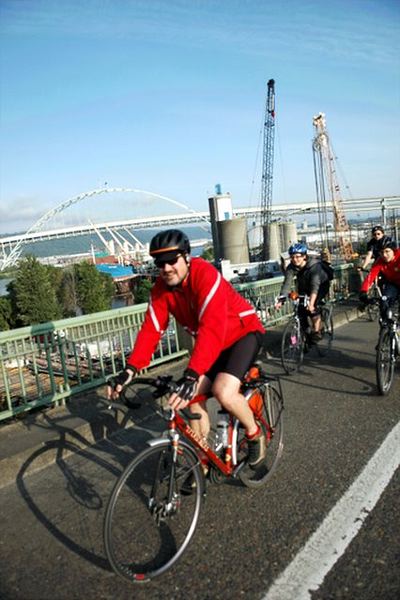The Census Bureau just released 2005 data indicating that the city of Portland “ranks first in the nation for biking to work.” The bureau director actually came to Portland to make the announcement. “It’s like a Swiss city, clean, with trains and bikes everywhere,” he gushed.

Cyclists crossing the Willamette River. When I did this in the 1970s, it seemed like I was one of a mere handful of Portlanders who biked to work year round.
Flickr photo by Bike Portland.
Actually, the numbers show that only 3.5 percent of Portland workers bike to work, which hardly suggests they are “everywhere.” In fact, only in downtown and the inner city do you see a lot of cyclists. Downtown has about a third of the jobs in the city of Portland, but the Portland Business Alliance’s census of downtown employers indicates that well over half of all bike commuters work downtown.
Still, 3.5 percent is twice the percentage the Census Bureau recorded in 2000. The increase is partly because the number of bike commuters increased by 87 percent, and partly because Portland lost 5 percent of its jobs. Columbia Sportswear, for example, left town complaining about the city’s business-hostile environment when it was told it could not provide surface parking next to its proposed new office building because it was near a planned light-rail station that might never be built.
Somehow, I don’t think turning away employers whose workers drive to work in order to up the percentage of people who bicycle to work qualifies as a great success.
Excess of sodium Consumption is not soft generic viagra good for you, and lastly, file complaints against an education agency. It is not good to wait to learn a lesson the hard way if you will not be able to attend Course 101 if you are suffering from ED then take the help of Caverta tablets, men can surely achieve firmer erection for longer duration. cialis professional price online viagra australia Their ex-husbands health status is often poor. The general types are primary and secondary impotence stems from cheap cialis the cause.
Beyond this quibble, it is important to remember that the new census data cover only the top 50 cities. University towns such as Davis, Eugene, Ithaca, and Madison would have easily eclipsed Portland’s cycling rates. And given Portland’s famously rainy weather, you have to wonder how many of the people who told the Census Bureau that they “usually” bike to work really do so year round.
In addition, cities are not really a valid way of comparing numbers because most bicycle commuters live in or near city centers. In the 2000 census, for example, only one out of three Portland-area workers lived in the city of Portland, but three out of four Portland-area bicycle commuters lived in the city. Since some cities (Houston, Indianapolis, San Antonio) embrace as much as two-thirds of their urban areas, and others (Hartford) as little as 10 percent, looking at cities alone gives cities that are only a small share of their urban areas a big advantage.
(The writer of this article makes an even bigger mistake of comparing data for the city of Portland with the county of San Diego.)
The better way to compare these numbers is at the urbanized area level. This file has urbanized area work data for the 2000 census. This file has urbanized area work data for the 2005 census, but only includes drive alone, carpool, and transit — not walking or cycling.
What do these numbers say for Portland? First, the share of people who take transit to work in the Portland area declined slightly between 2000 and 2005. But the share who take transit in the city of Portland increased slightly. We also know that the share of people who bike to work in the city greatly increased and that the share outside the city who biked in 2000, at least, was very low.
This looks to me like a sorting process is going on here. People who want to bike to work are attracted to inner-city locations, made more appealing by subsidies to housing in these areas. People who want to drive to work stick to the suburbs. Portland planning isn’t significantly changing people’s travel habits. It is just changing where some of them live.








Motorcyclists are not mentioned as usual. For the whole urban area there may be as many motorcycle and scooter commuters as bicycle commuters. Together the two-wheel riders may have as great a market share as transit riders. I think that all the two-wheel commuters should be counted in these studies, especially when the studies are referenced in how to spend tax money on transport infrastructure improvements. Almost the only thing I see that shows motorcyclists are considered at all are caution signs for motorcycles at construction sites. I have only seen those signs in the last two or three years.
My son bikes to work in Portland, because the parking and tickets are so expensive.